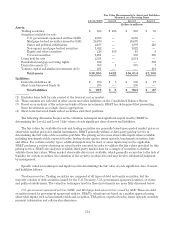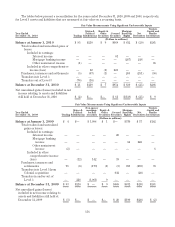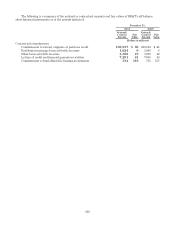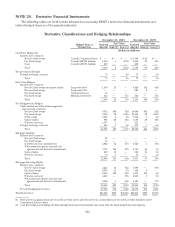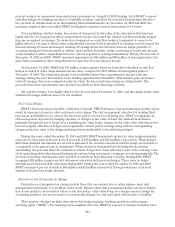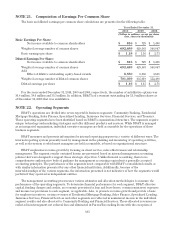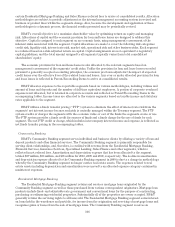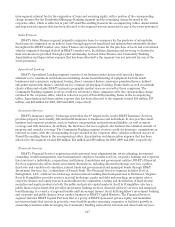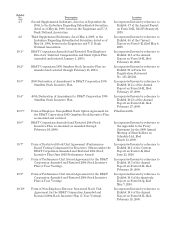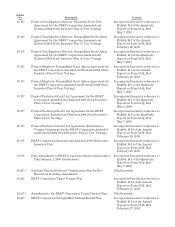BB&T 2010 Annual Report Download - page 164
Download and view the complete annual report
Please find page 164 of the 2010 BB&T annual report below. You can navigate through the pages in the report by either clicking on the pages listed below, or by using the keyword search tool below to find specific information within the annual report.and conditions subsequent to the interest rate lock and funding date. BB&T’s risk management strategy related
to its interest rate lock commitment derivatives and loans held for sale includes using mortgage-based
derivatives such as forward commitments and options in order to mitigate market risk. For MSRs, BB&T uses
various derivative instruments to mitigate the income statement effect of changes in the fair value of its MSRs.
For the year ended December 31, 2010, BB&T recorded a gain totaling $196 million related to these derivatives
which was offset by a decrease in the carrying value of mortgage servicing assets totaling $138 million. For the
year ended December 31, 2009, BB&T recognized a $98 million loss on these derivatives, which was offset by an
increase in the carrying value of mortgage servicing assets that totaled $190 million.
BB&T also held, as risk management instruments, other derivatives not designated as hedges primarily to
facilitate transactions on behalf of its clients, as well as activities related to balance sheet management.
Net Investment Hedges
In connection with a long term investment in a foreign subsidiary, BB&T is exposed to changes in the
carrying value of its investment as a result of changes in the related foreign exchange rate. At December 31, 2010
and 2009, BB&T used derivatives to hedge the variability in the value of its $73 million investment. For net
investment hedges, changes in value of qualifying hedges are deferred in other comprehensive income (loss) when
the terms of the derivative match the notional and currency risk being hedged. At December 31, 2010 and 2009,
accumulated other comprehensive income (loss) reflected unrecognized pre-tax losses totaling $11 million and $8
million, respectively, related to cumulative changes in the fair value of BB&T’s net investment hedge.
Derivatives Credit Risk
Credit risk related to derivatives arises when amounts receivable from a counterparty exceed those payable
to the same counterparty. BB&T controls the risk of loss by subjecting counterparties to credit reviews and
approvals similar to those used in making loans and other extensions of credit. In addition, certain counterparties
are required to provide cash collateral to BB&T when their unsecured loss positions exceed certain negotiated
limits. As of December 31, 2010 and 2009, BB&T had received cash collateral totaling $33 million and $82 million,
respectively.
Consistent with BB&T’s policies related to requiring cash collateral, counterparties to derivative
transactions may require BB&T to post cash collateral related to certain derivatives in a loss position. At
December 31, 2010 and 2009, BB&T had posted collateral totaling $605 million and $138 million, respectively,
related to derivatives in a loss position totaling $612 million and $188 million, respectively. In the event that
BB&T’s credit ratings had been downgraded below investment grade, the amount of collateral posted would have
increased by $10 million and $50 million as of December 31, 2010 and 2009, respectively.
As of December 31, 2010 and 2009, BB&T had $1 million and $26 million, respectively, of unsecured positions
with derivative dealers. All of the derivative contracts to which BB&T is a party settle monthly, quarterly or
semiannually. In the case of contracts with derivative dealers, BB&T only transacts with dealers that are national
market makers with strong credit ratings. Further, BB&T has netting agreements with the dealers with which it
does business. Because of these factors, BB&T’s credit risk exposure related to derivatives contracts at
December 31, 2010 and 2009 was not material.
164


